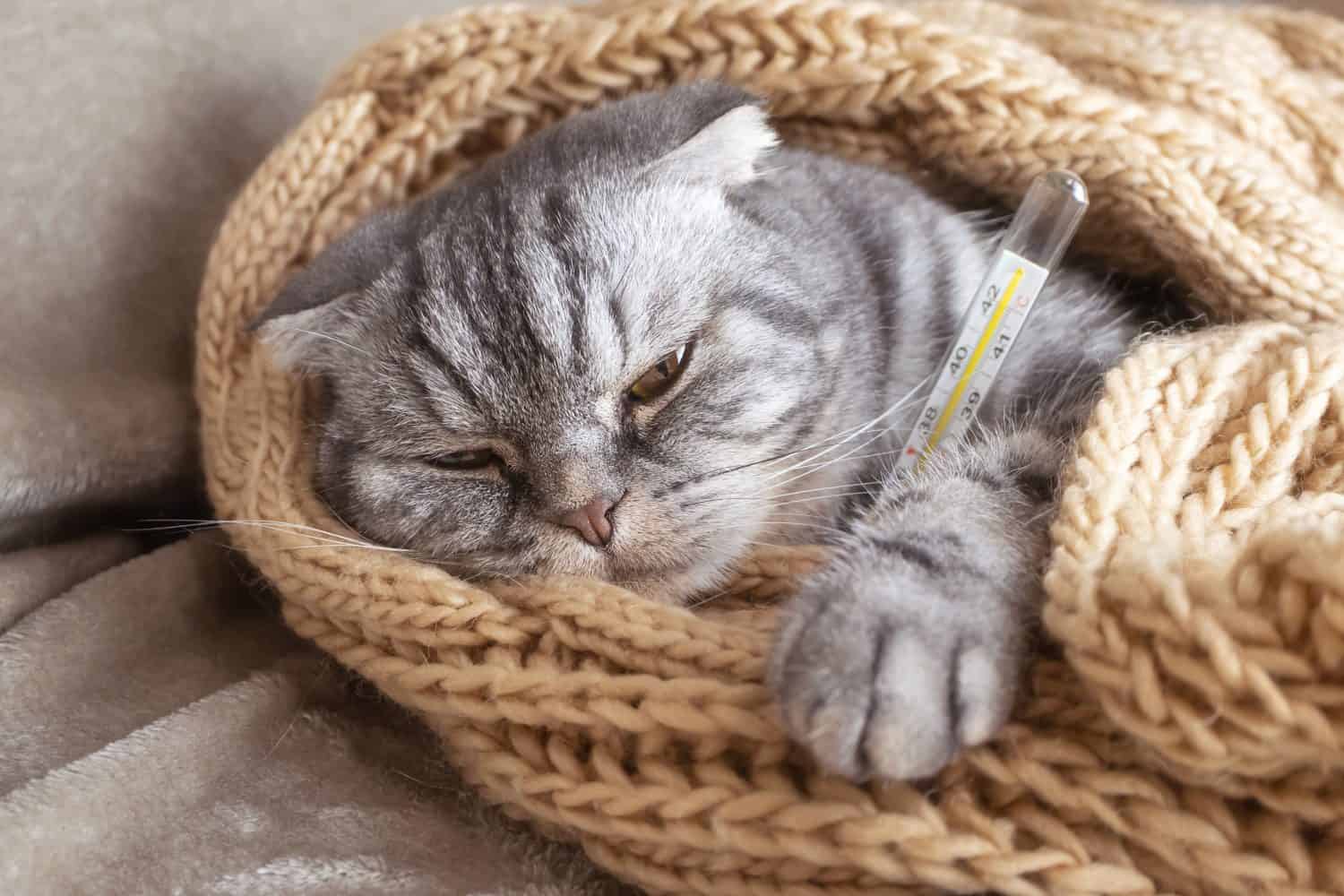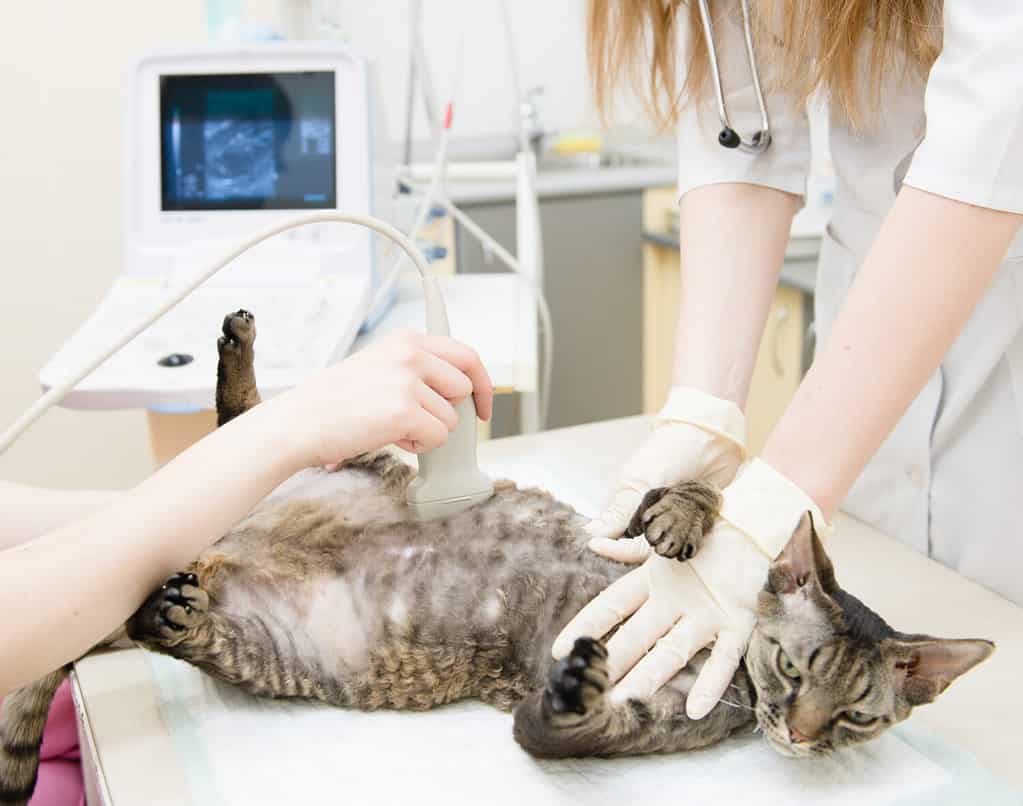It’s a rare condition, especially in felines, but mastitis can lead to a range of complications, including tissue death. If you know what causes it, how it presents, and how it’s treated, you can be proactive when you notice changes in your kitty. Learn about mastitis in cats, including what a cat-only vet has to say about this unique condition!
What Causes Mastitis in Cats?
Mastitis in cats occurs when the mammary tissue is infected with bacteria. This can occur after trauma to the area. However, it may occur if another infection in the body has traveled to the mammary glands. Another reason mastitis may develop is when a kitty has been inhabiting an unsanitary environment. It generally presents in female cats, especially while they are still nursing.
Dr. Wallace, a cat-only vet at Cozy Cat Veterinary Hospital in Raleigh, NC told A-Z-Animals, “Mastitis is not a common problem in cats, but giving the queen adequate space for nursing, and keeping the bedding clean and dry can help to prevent infection.”
Two primary types of mastitis occur in cats. The condition can be either septic or non-septic. When it’s septic, it’s because the breast infection has stemmed from a specific type of bacteria (either Staphylococci, E. coli or Streptococci). Typically, this is due to unclean environments and poor hygiene.

After giving birth, mother cats stay busy nursing. But during this period, they may also develop a rare condition called mastitis.
©Sheila Fitzgerald/Shutterstock.com
The other type of mastitis in cats is non-septic. This is when inflammation occurs in the mammary gland without an infection. This is typically caused by injury or when milk builds up in the cat’s glands. Often, this happens when a female cat is weaning. The symptoms cats experience may be similar whether the condition is septic or non-septic, but a correct diagnosis is necessary to administer the proper treatment.
Symptoms of Mastitis in Cats
Breast Changes
The types of changes that occur in breasts vary. Sometimes, the color changes and appears red or purple (almost black). The breast area may also feel different to the touch, sometimes hot and sometimes swollen and hard. You may notice open sores and scabs as well.
Pain
Whether it’s inflammation or an infection, it’s a painful condition for your cat. Cats respond differently to pain and may try to hide their discomfort. Behavior that’s outside of the norm can be an indicator that your kitty is experiencing pain due to mastitis.
Tainted Milk
When a female kitty is nursing, mastitis may cause changes to her breast milk. The milk may be thicker than usual and kind of cloudy. It may also include pus or blood.
Depression
This is another symptom that may be hard to spot but when you know your cat well, you can tell when they’re acting out of sorts. A depressed kitty may retreat and hide, avoid playtime, and may even experience changes in appetite. A kitty who is normally excited for dinner and suddenly lets the wet food or kibble sit may be experiencing depression as a symptom of mastitis.
Fever

If a cat has septic mastitis, they may develop a fever as their bodies work to fight off the infection.
©kholywood/Shutterstock.com
Mastitis may also cause fever in cats if there is an infection present. This is your cat’s natural bodily response to fight the infection. However, if your kitty has non-septic mastitis, fever may not present as a symptom.
Kitten Neglect
A nursing mother cat may start to neglect her kittens if she has mastitis. At this point, the condition has typically progressed and requires immediate veterinary treatment. When a mother cat is unable to properly care for her kittens, you must ensure that the kittens have access to kitten milk so they can continue getting the nutrients they need.
Vomiting
If your cat is suffering from mastitis, you may also notice vomiting. Sometimes, vomiting occurs for other reasons but if you suspect mastitis, take a look at your cat’s breasts to look for any noticeable changes.
Lethargy
A nursing cat is already giving up much of her energy, and you can expect her to be tired immediately after giving birth. But mastitis can also present with lethargy. This can persist and will likely be noticeable to you if you’re familiar with her usual disposition.
Potential Mastitis Complications
Generally, mastitis has a good outcome. When treatment is provided, you can expect your cat to feel better in two to three weeks. However, in some cases, there may be complications. If your kitty is dealing with septic mastitis, infections can get quite severe. When this occurs, your kitty may experience a host of other symptoms, including dehydration. If your kitty is dehydrated, IV infusions can help.
With severe infection, your cat may also experience shock. If there is an abscess and bacteria is present, your vet may need to perform a minor surgery to drain it and thoroughly clean the area. Another complication is tissue death, which requires veterinary care. In the case of a complication, your kitty may need to be hospitalized for around-the-clock monitoring until it’s safe for them to return home.

In some mastitis cases, there may be complications, which means more time spent at the vet.
©Ermolaev Alexander/Shutterstock.com
These veterinary costs can stack up, which is why it’s always a good idea to consider pet insurance for your feline friends. With an insurance policy, you can rest easy knowing you don’t have to hesitate about treatment for your cat with mastitis (or any other condition, so long as it’s not pre-existing).
How Is Mastitis in Cats Diagnosed?
When a cat presents with mastitis, it’s generally obvious to your vet. However, your vet will follow through with assessing your kitty’s medical history and will ask you questions about any symptoms you’ve noticed. They will also perform a physical exam. Sometimes, this involves taking some milk from your cat’s nipple for further analysis to determine if there are signs of infection.
While a physical exam is usually enough for a diagnosis, it is also possible that your vet may want to conduct additional tests just to be sure. For example, a blood test can inform your vet whether an infection is present, which would point to a septic condition. Your vet may also want to check for the exact bacterial strain by performing a bacteria culture test.
Treatment for Mastitis in Cats
If you’re dealing with septic mastitis, which is when there is a bacterial infection present, your vet will start treatment by administering antibiotics to fight the infection. Additionally, your vet may prescribe pain medication for your kitty’s comfort. If your cat is still nursing, your vet will be mindful to prescribe only certain types of antibiotics and avoid others, as the medication may pass through the milk to the kittens.
If your cat does not have septic mastitis, your vet typically won’t prescribe medication. However, there are some actions you can take to help your kitty at home, whether the mastitis is non-septic or septic. For example, your vet may suggest you use a warm compress on the area several times per day to help alleviate the pain and encourage the mammary gland to drain.
If kittens are still nursing, you can encourage them to nurse, which also helps relieve the cat’s discomfort. However, if kittens are already weaned, you may need to step in to drain some of the milk with your hands. This should be done gently. Aside from a warm compress, you can try using a cool cabbage leaf compress to relieve pain as well. However, before offering any at-home treatment, be sure to consult with your veterinarian.
Thank you for reading! Have some feedback for us? Contact the AZ Animals editorial team.








